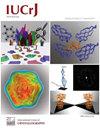用光笼底物重新审视DNA糖基酶的共晶结构:一个合适的时间分辨晶体学目标?
IF 3.6
2区 材料科学
Q2 CHEMISTRY, MULTIDISCIPLINARY
引用次数: 0
摘要
碱基切除DNA修复酶(人8-氧鸟嘌呤DNA糖基化酶)的共晶结构在2.81和2.48 Å分辨率的光照下,分别检测hOgg1)和8-氧鸟嘌呤DNA病变的复合物。这些结构被仔细地重新评估,以迅速扩大光触发时间分辨大分子晶体学的目标库。解封后的中后期低温捕获显示,8-氧鸟嘌呤在活性位点的部分容纳率为68%,这并没有诱导活性位点完全适应催化状态。晶体光照导致衍射功率的光依赖性损失,可能是由于晶体填料在非常晚的反应阶段坍塌。因此,这项工作不仅证明了hOgg1非常适合于时间分辨晶体学,而且表明这种分析对于确定其反应的进一步步骤是必要的。本文章由计算机程序翻译,如有差异,请以英文原文为准。
Revisiting the co-crystal structure of a DNA glycosylase with photocaged substrate: a suitable time-resolved crystallography target?
Engineered in crystallo photosensitivity in a DNA-repair enzyme is carefully assessed for its suitability as a target for time-resolved crystallographic studies.
Co-crystal structures of a base-excision DNA-repair enzyme (human 8-oxoguanine DNA glycosylase; hOgg1) in complex with a photocaged 8-oxoguanine DNA lesion were determined before and after uncaging via illumination at 2.81 and 2.48 Å resolution, respectively. The structures were carefully reassessed to rapidly expand the target repertoire of light-triggered time-resolved macromolecular crystallography. Late-intermediate cryo-trapping after uncaging revealed the partial accommodation of 8-oxoguanine in the active site with 68% occupancy, which did not induce full active-site adaptation to the catalytic state. Crystal illumination led to a light-dependent loss of diffraction power, likely due to crystal-packing collapse during the very late reaction stages. This work therefore not only demonstrates that hOgg1 is well suited for time-resolved crystallography, but also that such analysis is necessary to determine further steps in its reaction.
求助全文
通过发布文献求助,成功后即可免费获取论文全文。
去求助
来源期刊

IUCrJ
CHEMISTRY, MULTIDISCIPLINARYCRYSTALLOGRAPH-CRYSTALLOGRAPHY
CiteScore
7.50
自引率
5.10%
发文量
95
审稿时长
10 weeks
期刊介绍:
IUCrJ is a new fully open-access peer-reviewed journal from the International Union of Crystallography (IUCr).
The journal will publish high-profile articles on all aspects of the sciences and technologies supported by the IUCr via its commissions, including emerging fields where structural results underpin the science reported in the article. Our aim is to make IUCrJ the natural home for high-quality structural science results. Chemists, biologists, physicists and material scientists will be actively encouraged to report their structural studies in IUCrJ.
 求助内容:
求助内容: 应助结果提醒方式:
应助结果提醒方式:


